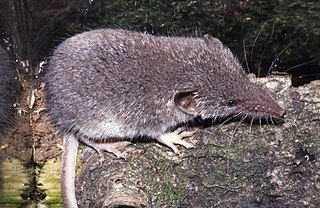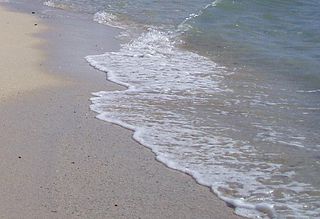
Manhattan Beach is a city in southwestern Los Angeles County, California, United States, on the Pacific coast south of El Segundo, west of Hawthorne and Redondo Beach, and north of Hermosa Beach. As of the 2020 census, the population was 35,506.

The lesser white-toothed shrew is a small species of shrew with a widespread distribution in Africa, Asia and Europe. Its preferred habitat is scrub and gardens and it feeds on insects, arachnids, worms, gastropods, newts and small rodents, though its diet usually varies according to the biotope where it lives. The closely related Asian lesser white-toothed shrew was once included in this species, but is now considered to be a separate species.

Mākena State Park is a 165-acre (0.7 km2) beachside park in Makena on the island of Maui, Hawaii. Located just south of Wailea, it contains three separate beaches and a dormant volcanic cinder cone.

Swash, or forewash in geography, is a turbulent layer of water that washes up on the beach after an incoming wave has broken. The swash action can move beach materials up and down the beach, which results in the cross-shore sediment exchange. The time-scale of swash motion varies from seconds to minutes depending on the type of beach. Greater swash generally occurs on flatter beaches. The swash motion plays the primary role in the formation of morphological features and their changes in the swash zone. The swash action also plays an important role as one of the instantaneous processes in wider coastal morphodynamics.

The Palm Beach Inlet, also known as the Lake Worth Inlet is an artificial cut through a barrier island connecting the northern part of the Lake Worth Lagoon in Palm Beach County, Florida with the Atlantic Ocean. It is bordered by the town of Palm Beach on the south, and by the town of Palm Beach Shores to the north. The inlet is also the entrance channel for the Port of Palm Beach. Its coordinates are 26°46′20″N80°02′14″W.

Gut River is a river, beach and small hamlet on an isolated stretch of south facing coastline in Manchester, Jamaica. The name is said by the locals to derive from the German word for good.

Red Sand Beach, a.k.a.Kaihalulu Beach, is a pocket beach located on Kaihalulu Bay. It is on the island of Maui, Hawaii, on Kaʻuiki Head.

Hippoidea is a superfamily of decapod crustaceans known as mole crabs or sand crabs.

Weston Mouth is an isolated beach on the East Devon coast between Sidmouth and Seaton in England. It can be reached only by footpath, either along the South West Coast Path or from the village of Weston. The beach is mostly shingle with some sand at low tide, and has no facilities.
Wasque ("way-squee") or Wasque Beach is a 200-acre (0.81 km2) nature reserve on Chappaquiddick Island, Martha's Vineyard, Massachusetts. The site was established as a reservation for the public in 1967 and is one of five conservation areas on "the Vineyard" managed by the Trustees of Reservations. Wasque contains a sandy strand the Boston Globe calls "a magnificent beach." Travel + Leisure named Wasque Beach the number one beach in New England and WHDH-TV reports "It's pristine, serene, and rain or shine, it's a beach-goers' delight." Off the shore of Wasque Beach is Katama Bay, "a vast and pristine salt water bay that includes many acres of productive shellfish beds."

Sand is a granular material composed of finely divided mineral particles. Sand has various compositions but is defined by its grain size. Sand grains are smaller than gravel and coarser than silt. Sand can also refer to a textural class of soil or soil type; i.e., a soil containing more than 85 percent sand-sized particles by mass.
Nitratireductor aquibiodomus is a Gram-negative, rod-shaped bacteria from the genus of Nitratireductor which was isolated from a marine denitrification system in Canada.
Nitratireductor aquimarinus is a Gram-negative, aerobic bacteria from the genus of Nitratireductor which was isolated from Skeletonema costatum from the Sea of Japan.
Nitratireductor indicus is a Gram-negative, oxidase- and catalase-positive mobile bacteria from the genus of Nitratireductor which was isolated from deep-sea water of the Indian Ocean.
Nitratireductor kimnyeongensis is a Gram-negative, aerobic, oxidase- and catalase-positive bacteria from the genus of Nitratireductor which was isolated from the Kimnyeong Beach in Jeju from the Republic of Korea.
Nitratireductor pacificus is a Gram-negative and motile bacteria from the genus of Nitratireductor which was isolated from enriched sediment from the Pacific Ocean.
Streptomyces bacillaris is a bacterium species from the genus of Streptomyces which has been isolated from forest soil in Oregon in the United States.
Nitratireductor lacus is a Gram-negative bacteria from the genus of Nitratireductor which has been isolated from the Yuncheng Salt Lake in China.
Brevundimonas basaltis is a Gram-negative, aerobic, rod-shaped and motile bacterium from the genus of Brevundimonas which has been isolated from black sand from Soesokkak in Korea.
Flaviramulus basaltis is a Gram-negative and motile bacterium from the genus of Flaviramulus.









